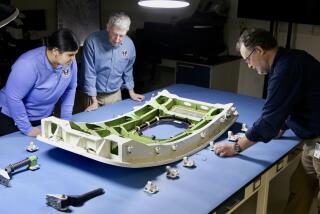FBI Investigating Douglas’ Rivets on C-17 Cargo Jets
- Share via
Federal agents are investigating allegations that McDonnell Douglas employees improperly installed thousands of rivets in the wings of Air Force C-17 cargo jets, creating a potential safety hazard.
The rivet problems and a related allegation that quality control records were altered to cover up the rivet deficiencies are being looked at by the FBI, according to Pentagon and industry sources. An FBI spokesman said the agency could not comment.
The allegations first surfaced late last year when the firm’s Douglas Aircraft unit in Long Beach, which is building the C-17, began an internal investigation and notified the Air Force of the case, The Times has learned.
In a statement issued in response to a reporter’s inquiries, Douglas officials acknowledged that they “became aware of a process control issue with our automatic fastening system” but added that they “determined that there was no significant impact on the product.”
The statement continued: “We are making a full report of our review to the Air Force, and we understand that as a matter of policy the Air Force is required to validate our actions to close out this issue.”
Douglas spokesmen characterized the issue as minor and the internal investigation closed, adding that they had no information about an FBI investigation. But some Pentagon officials, defense industry sources and three Douglas employees have a less-upbeat assessment.
“Nobody knows for sure how serious this problem is,” said a C-17 engineering official at Douglas. “It could be very serious, but not insurmountable, to fix. What we have to do is determine the dimensions of what happened.”
The concern is that thousands of rivets were apparently improperly installed by an automated drilling and riveting machine, known as a Drivematic. At issue is whether the Drivematic inserted the rivets with an improper amount of force, resulting in some rivets being over-stressed and some rivets being under-stressed, according to Douglas employees.
If rivet stresses are out of line with specifications, it could eventually lead to fatigue cracks between rivet holes, according to the Douglas sources. Ultimately, a series of such cracks could unite into a large crack that would threaten the structural integrity of the wing.
“The worst case scenario is that it could lead to catastrophic failure of the wing; but now that we know the problem exists, that isn’t going to happen,” a Douglas technical expert said. “Douglas won’t stand for that.”
If the problem is widespread, however, the cost to repair the existing wings could be substantial. One expert said each C-17 wing contains 110,000 rivets, and by some internal estimates 30% to 40% of the rivets could have been improperly installed.
It is unclear how many sets of wings have been affected. Douglas is under contract to develop and produce the first six C-17 aircraft, the Air Force’s next generation cargo transport plane. The first C-17 has been built and is being prepared for a maiden flight by this June.
The related federal investigation into the alteration of quality control records involves the allegation that the documents were changed to cover up the technical problems. So-called “test coupons,” which are pieces of metal used to test the rivet tolerances for each production run of the Drivematic, are missing, sources said.
In January, Under Secretary for Defense Donald Yockey visited the Douglas plant, reportedly to review a number of technical problems on the C-17 aircraft. A spokeswoman for Yockey declined to say why he visited Douglas.
The Drivematics, produced by Buffalo-based Gemcorp, have been a major problem for Douglas since C-17 production began. They were designed to drill, countersink and install about 30 rivets per minute, but they initially were operating at just seven rivets per minute. After intensive efforts to improve the machines, they are operating at about 15 to 18 rivets per minute, according to two Douglas officials.
Those experts worry that if the rate is not improved further, the company may have trouble meeting future schedules to build 12 aircraft per year.
More to Read
Inside the business of entertainment
The Wide Shot brings you news, analysis and insights on everything from streaming wars to production — and what it all means for the future.
You may occasionally receive promotional content from the Los Angeles Times.











